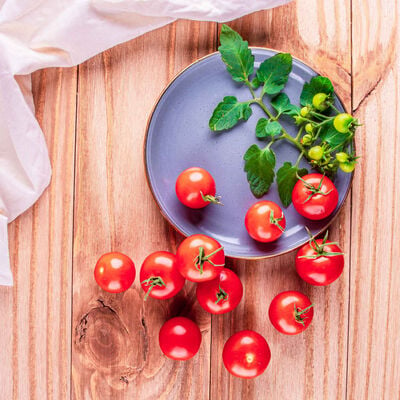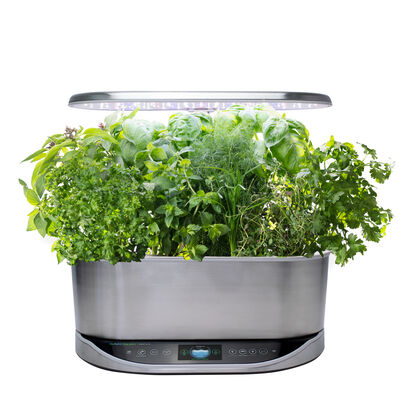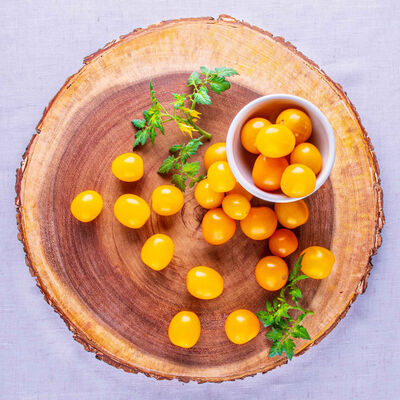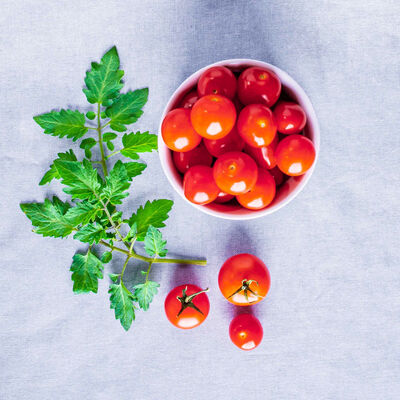
Growing Tomatoes Indoors: Must-Know Tips
Ready to grow fresh, vine-ripened tomatoes in your own home? Use this guide for tips and tricks on how to successfully grow tomato plants indoors.
Peak tomato season might be over, but that doesn't mean you can't cultivate your own fresh, vine-ripened tomatoes with an indoor garden. From mini cherry tomatoes to colorful heirloom tomatoes, this bright, flavorful fruit (often mistaken for a vegetable) is delicious served year-round in salads, sauces, soups and more. The possibilities are truly endless once you master the art of growing tomatoes indoors.
For ease of reading, we will refer to "tomatoes" throughout this discussion, however most of what we share applies equally to peppers.
5 Important Factors When Growing Indoor Tomatoes
Here are the most important factors to consider when tending to an indoor tomato plant:
1) Light
Light is the most critical determining factor in tomato yields when growing indoors. While we have seen pictures of tomatoes growing (and yielding tomatoes) in big dirt pots in sunny windows, that is much more the exception than the rule. Most likely, the tomatoes will end up stretching for light, looking stringy, and not setting fruit.
The most basic rule for growing tomatoes indoors is this:
MORE LIGHT = MORE TOMATOES
That basic rule holds true with any tomato plant, dwarf or large, and the larger the tomato plant, the more light it needs. We'll touch on that more next in the "variety" section.
AeroGardens feature built-in indoor grow lights that are good for growing the types of tomato plants we offer. AeroGardens aside, there are many types of residential grow lights on the market, from high powered, 1,000 watt metal halides (with their associate noise and heat), to LEDs to fluorescents. Stay away from the incandescent grow lights, which seem designed to make plants LOOK good, but do little for growth.
What kind of grow lights you choose will depend on the area that you're looking to cover, your budget, and how attractive the lights need to be. But with tomatoes and peppers, keep in mind that more is always better for best yields.
2) Variety
Choosing the right variety of tomato for indoor gardening is key to your success. Between heirlooms and bred varieties, there are likely 500 to 750 active tomato varieties on the market at any one time. Tomatoes come in a stunning variety of plant sizes, growth habits, leaf shapes, fruit sizes and flavors.
In the AeroGarden lab, we've tested almost 500 varieties of tomato seeds, looking for the ones that stay the right height, look attractive as they grow, and produce a lot of tasty fruit. But we offer just a few of the hundreds of varieties available. Experiment!
For peppers, variety is still important, but less so. Some pepper plants may grow to 6 feet tall, but most stay about perfectly sized for indoor gardening. Jalapenos, Habaneros, Asian peppers and certain dwarf Bells all do extremely well in indoor gardening situations.
3) Water & Nutrients
Because of their size and fast rate of growth, tomatoes and peppers have different nutrient and water needs than your average houseplant. Both grow well in hydroponic or soil-based gardens, however almost any hydroponic system will grow much more quickly than dirt.
As tomato seedlings grow, they start using water much faster. A common mistake made by tomato growers is not increasing the frequency of watering as plants grow. Many first time gardeners wake up one morning to find their dirt dry (and their tomato wilted) or their hydroponic reservoir empty. As plants grow, check water usage frequently! Dead tomato plants produce no fruit.
Because of their fast growth, tomatoes also deplete soil nutrients at a much faster pace. Tomatoes are heavy feeders, and benefit from frequent additions of a full spectrum nutrient. AeroGarden nutrients, at 4ml per gallon of water added, are a great way to feed your tomatoes, but any hydroponic nutrient will do.
In a hydroponic setup, a good hydroponic nutrient, coupled with frequent water changes are critical. AeroGarden nutrients are well suited for this, but any commercially available formula should work. Follow instructions on the nutrients regarding mixing strength. Do a complete water change every two weeks for best plant health.
Bloom formulas are not needed, and add a level of complexity that is hard for some growers to manage. Bloom formulas might increase yields 5% or so, which is important on a greenhouse scale, but might not increase your yields by even one tomato on one or two plants indoors, while greatly increasing the complexity of the grow. Most bloom formulas on the market are geared toward a certain, unnamed "high value" cash crop.
4) Pollination
Luckily for indoor growers, tomato and pepper plants contain both male and female components in each flower, and are self-pollinating. However, in nature, wind and insects shake the pollen from one part of the flower to another.
When growing indoors, you need to be the wind, or the bug, your choice. Either way, when flowers appear and open, start gently shaking the plants a few times a day (or point a fan at the plants) in order to shake the pollen loose and set fruit. If all other conditions are right, you should see tiny fruits beginning to form within a few days.
5) Patience
The number one enemy of successful indoor harvests of tomatoes and peppers is impatience. From the moment of planting, you are likely at least 90 days away from a first harvest, and sometimes more. While tomatoes grow rapidly and start to flower quickly (often within 30 days in hydroponic setups) it will take another 30 days for fruit to grow and another 30 days, or more, to ripen. During that time your plant will change from cute little tomato plants to tall, sometimes not so attractive plants.
The bias is to assume something is wrong with your tomatoes. It is not, it just takes time.
And tomatoes and peppers are notoriously fickle indoors. They set fruit, it seems on their own pace only. Currently we have been waiting for 90 days for some beautiful habañero plants we have to set fruit. We are getting lots of flowers, beautiful foliage, but no fruit set. However, we know they are getting what they need. Plenty of light, and good nutrients. Sooner or later, the fruit will set.
Sometimes, like in the above example, flowers will form and drop off. This is sometimes a light issue, but as often as not, that plant just isn't ready yet. Patience is key.
Conclusion
As a dedicated indoor gardener, tomatoes and peppers can be some of the most challenging, and rewarding, crops to attempt indoors. AeroGardens have taken a lot of the guesswork out by testing and selecting several varieties of tomatoes, and by offering different garden models that will produce different results.
Conclusion
As a dedicated indoor gardener, tomatoes and peppers can be some of the most challenging, and rewarding, crops to attempt indoors. AeroGardens have taken a lot of the guesswork out by testing and selecting several varieties of tomatoes, and by offering different garden models that will produce different results.





